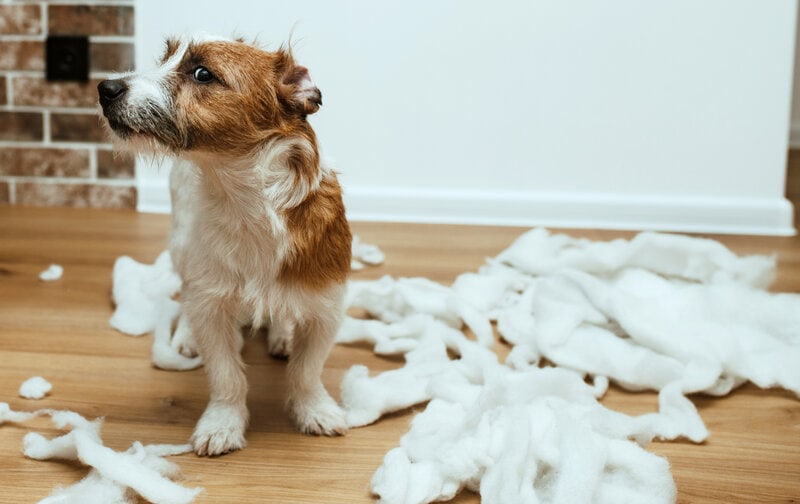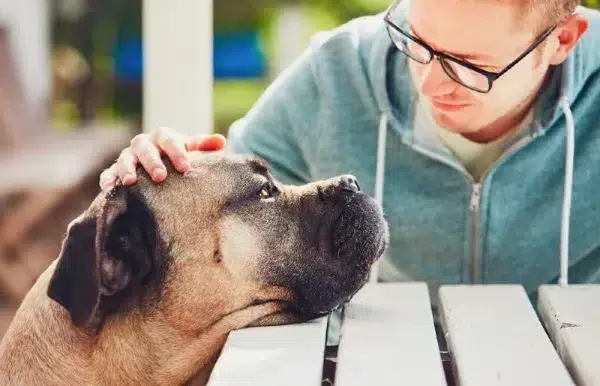In this article
View 2 More +As you come in the door from work, your best friend is anxiously waiting to greet you. The wagging tail and the whine of excitement make for the best homecoming ever. Then you see it. The trash can is toppled over, and the garbage is everywhere. Your first reaction is dismay. Then you look at your pup. They respond with that look. You know the one. Their eye sadly looking up at you, the ears bent back and the tail between the legs.
They know you are upset but do they know they did something wrong? Are they reacting to your disappointment or angry behavior? Are they feeling guilt or shame? More likely, they are expressing signs of fear or anxiety because dogs do not process guilt and shame.

Do Dogs Know They Did Something Wrong?
This may be a trick question. Dogs do know they did something wrong, but only because we tell them. Their natural instincts are survival. If there is food, they take it. Humans go to the grocery store. We do not feel guilty because it is a natural behavior or occurrence in our lives. When we need food, we go to get it. Same with dogs. If they want or need food, they take it.
Unlike humans, dogs do not process guilt and shame. They do not rationalize to determine if their behavior is appropriate; they learn from us. We correct our pets if we catch them breaking the rules.
For instance, if your dog starts peeing on the carpet, a quick “no” and putting him outside sends the message. The dog learns that you want him to pee outside and not in the house. Essentially, they have no regard for what is right or wrong—they are just doing what they were trained to do.

Can Dogs Feel Guilt or Shame?
So, your dog looks shameful or guilty, or does he? According to the veterinary scientist Susan Hazel, “Dogs do not feel or display guilt. It’s not the way their brains work.”
As owners, we may want to think our dogs feel remorse for making us clean up the garbage or the mess on the rug. The truth is that they are not expressing guilt or shame; they are being submissive and reacting to our tone of voice or body language. Realizing they have done something to upset you, they will give you looks to melt your heart and calm you down. Unfortunately, what we perceive to be expressions of guilt or shame, are signs of stress and fear in our pouch.
- Showing the whites of his eyes
- Yawning
- Tucking his tail
- Licking
- Won’t make eye contact
- Cowering down
- Flattening his ears
Many owners find it cute or funny to see this reaction. When, in fact, you can be causing fear and anxiety in your pet.
Dog Shaming
We have all seen the videos of dogs looking guilty. It seems harmless. Pet owners are filming their pets as they interrogate them about the mess they made. It is adorable to watch, but is it good for our pets? If the behaviors displayed are fear and anxiety, we may be causing stress for our faithful companions.
While shaming your little pouch is cute and playful for you, it may not feel so good to him. Whether the issue is related to anxiety, health, or training, it is important to have it corrected. Doing so can prevent chronic behavioral problems in the future.

Summary
We all enjoy an occasional dog shaming video. We think they are cute and funny. However, what you see are fear and anxiety. The bottom line is that dogs do not feel guilty. What you see are cause and effect.
So, which one is cuter? A video of a dog looking shameful or a dog that is proud, confident, and happy. You be the judge!
See Also:
- What Do Dogs Think About All Day? Understanding the Canine Mind
- Do Dogs Get Embarrassed? Understanding Canine Behavior
Featured Image Credit: san4ezz, Shutterstock




















